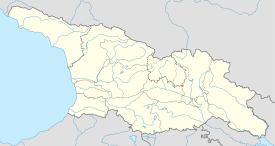
Back Пицундатәи ауахәама Abkhazian كاتدرائيه بيتسوندا ARZ Pitsunda kafedralı Azerbaijani Пицунда ҡорамы Bashkir Патрыяршы сабор у Піцундзе Byelorussian Свети Андрей (Пицунда) Bulgarian Catedral de Pitsunda Catalan Katedrála svatého Ondřeje (Picunda) Czech Catedral de Pitsunda Spanish Պիցունդայի մայր տաճար Armenian
| St. Andrew the Apostle Cathedral | |
|---|---|
 | |
| Religion | |
| Affiliation | de facto: Abkhazian Orthodox Church de jure: Georgian Orthodox Church[a] |
| District | Gagra District |
| Region | Caucasus |
| Status | Active |
| Location | |
| Location | Pitsunda, Gagra District, |
| Geographic coordinates | 43°09′36″N 40°20′20″E / 43.159889°N 40.339°E |
| Architecture | |
| Type | Triple-nave, domed cruciform plan |
| Style | Georgian; Byzantine |
| Funded by | King Bagrat III of Georgia |
| Completed | End of 10th century |
| Specifications | |
| Length | 37 |
| Width | 25 |
| Height (max) | 29 |
| Dome(s) | 1 |
| Website | |
| Pipe organ of Pitsunda | |
The Cathedral of St. Andrew the Apostle (Russian: Собор в честь Апостола Андрея Первозванного, romanized: Sobor v chest' Apostola Andreya Pervozvannogo), also known as the Pitsunda Cathedral (Abkhaz: Пицундатәи ауахәама, romanized: Ṗicundaṭ°i awax°ama) or Bichvinta Cathedral (Georgian: ბიჭვინთის ტაძარი, romanized: bich'vintis t'adzari) is an Eastern Orthodox Cathedral located in Pitsunda, in the Gagra District of the de facto independent Republic of Abkhazia, internationally recognised as constituting a part of Georgia. The cathedral is currently used by the schismatic Abkhazian Orthodox Church and serves as that body's seat, although this usage is disputed by the Georgian Orthodox Church and is considered irregular by the Eastern Orthodox communion generally.
Pitsunda Cathedral was built at the end of the 10th century by King Bagrat III of Georgia. It served as the seat of the Georgian Orthodox Catholicate of Abkhazia until the late 16th century when Abkhazia came under the Ottoman hegemony. According to 17th century French traveller Jean Chardin, Catholicos, who no longer lived in Pitsunda, visited the cathedral once a year with the retinue of bishops and princes to perform the sanctification of chrism.[1] The cathedral was reconsecrated in 1869 when Abkhazia was already a part of Russian Empire.[1]
It is a cross-domed cathedral with three naves and three apses, shaped as a rectangle with extending semicircular apses. It holds a pipe organ from the Alexander Schuke factory in Potsdam, Germany, installed in 1975.[2] The cathedral is notable for its impressive size, reaching 29 m high (including the dome), 37 m long and 25 m wide; the walls are up to 1.5 m thick. The building rests on heavy slabs of grey sandstone; the walls are made up of alternating rows of stone and brickwork, a typical technique for late Byzantine architecture. The cathedral contains vestiges of wall-painting from the 13th and the 16th centuries. A 12th-century Georgian manuscript of the Four Gospels, found at the cathedral in 1830, is now preserved at the Georgian National Center of Manuscripts in Tbilisi.
Cite error: There are <ref group=lower-alpha> tags or {{efn}} templates on this page, but the references will not show without a {{reflist|group=lower-alpha}} template or {{notelist}} template (see the help page).
- ^ a b Акты собранные Кавказскою Археографическою Комиссиею (Acts of Caucasian Archeographic Commission), v. 5, pp. 1069-1070, cited by Экзеков, Мусса (2012). По обе стороны Большого Кавказа. Сборник документов (1-я половина XIX века). Том II. Питер. pp. 574–575. ISBN 9785459008906.
- ^ Schuke. "Complete List of Organs since 1820" (PDF). Schuke / Internet Archive. Archived from the original (PDF) on 2016-01-15. Retrieved 3 April 2023.
